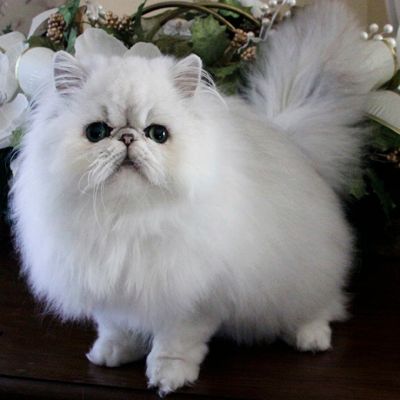Persian cats, known for their luxurious coats and sweet personalities, have captivated cat lovers for centuries. This post explores five distinct types of Persian cats, their histories, characteristics, and status in the cat show ring.
1. traditional Persian (dollface Persian)

history and origin
The Traditional Persian, often called the Doll Face Persian, represents the original Persian breed. These cats originated in Persia (modern-day Iran) and Turkey, with records dating back to 1684 BCE. They were introduced to Europe in the 17th century, quickly becoming favorites among nobility.
distinctive features
Traditional Persians retain the original facial structure of the Persian breed, featuring a longer nose and less extreme facial features compared to the (Flat) Peke-Face Persian. Their noses are more pronounced, giving them a "doll-like" appearance. They have a sweet expression and are often considered healthier due to their less exaggerated features.
show status and pedigree
- Pedigree Status: Not a recognized breed, despite being the original / traditional Persian cat.
- Cat Fanciers' Association (CFA): Generally not accepted
- The International Cat Association (TICA): Partially accepted (as "Traditional Longhair" or in non-championship classes)
- Governing Council of the Cat Fancy (GCCF): Generally not accepted
2. flat-face Persian (Ultra-Type Persian)
history and origin
The Peke-Face or Ultra-Type Persian emerged in the 1950s when breeders selected for a flatter face and smaller nose. The name "Peke-Face" comes from their resemblance to Pekingese dogs.
distinctive features
Named for their resemblance to the flat-faced Pekingese dog, these Persians have a very flat face with a snub nose and large, round eyes. This look is the result of selective breeding and is popular in cat shows. Characterized by extremely flat faces, large round eyes, small noses, and chubby cheeks. They have a more "smooshed" appearance compared to Traditional Persians. This is the type of Persian cat Bombom is.
show status and pedigree
- Pedigree Status: Recognized breed
- CFA: Accepted and preferred
- TICA: Accepted
- GCCF: Accepted
3. himalayan Persian (colorpoint Persian)

history and origin
Developed in the 1930s by crossing Persians with Siamese cats, Himalayans were recognized as a distinct breed in the 1950s.
distinctive features
A cross between Persians and Siamese cats, Himalayans have the body type of a Persian with the colorpoint markings of a Siamese. They feature blue eyes and darker coloration on the ears, face, paws, and tail.
show status and pedigree
- Pedigree Status: Recognized breed (either as a Persian color variant or separate breed, depending on the association)
- CFA: Accepted as a color division of Persians
- TICA: Recognized as a separate breed
- GCCF: Recognized as Colourpoint Persians
4. exotic shorthair

history and origin
Developed in the 1960s by crossing American Shorthairs with Persians, aiming to bring in the silver color and green eyes of the Persian.
distinctive features
Often called the "Lazy Man's Persian," the Exotic Shorthair has the same body type and facial features as a "peke" faced Persian but with a short, dense coat that's easier to care for. Ollie is an Exotic Shorthair cat.
show status and pedigree
- Pedigree Status: Recognized as a separate breed and compete in their own category specifically for Exotics.
- CFA: Accepted as a separate breed
- TICA: Accepted as a separate breed
- GCCF: Accepted as a separate breed
5. chinchilla Persian

history and origin
Emerged in the 1880s in the UK, named after the South American rodent due to its similar coloring. The first Chinchilla, "Chinnie," resulted from a chance mating between a blue Persian and a stray tom.
distinctive features
Chinchillas have a pale silver or gold undercoat with black-tipped hairs, giving them a shimmering appearance. They often have green or blue-green eyes.
show status and pedigree
- Pedigree Status: Recognized breed (sometimes as a Persian color variant, sometimes as a separate breed)
- CFA: Accepted under the Silver and Golden Division
- TICA: Accepted
- GCCF: Sometimes recognized as a separate breed called Chinchilla Longhair
a note on "teacup" Persians
"Teacup" or "Toy" Persians are not recognized as official breeds by any major cat association. The term usually refers to undersized Persians, often the result of breeding runts or using questionable breeding practices to achieve a smaller size. Most reputable breeders and veterinarians discourage the intentional breeding of extremely small cats due to potential health issues.
- pedigree status: Not a recognized breed
- show status: Not accepted by CFA, TICA, or GCCF due to welfare concerns
show ring considerations
For those interested in showing Persian cats:
- breed standards: Each association has detailed standards specifying ideal characteristics.
- registration: Cats must be registered with the association holding the show to compete.
- health and welfare: Associations prioritize cat health and welfare.
- grooming: Extensive grooming is required to meet show standards.
Persian cats, regardless of type, require dedicated care and grooming. Their long coats need daily attention, and some may have special health considerations due to their facial structure. However, for those willing to provide the necessary care, Persian cats offer a unique blend of beauty and affectionate companionship.